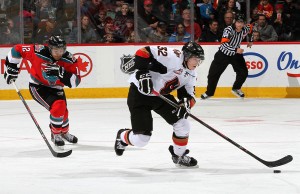
On Wednesday, the Philadelphia Flyers Director of Scouting, Chris Pryor, indicated that the team would be picking the best available player with each pick in the draft, regardless of position. This strategy is the wisest one when considering the unpredictability of projecting teenagers while trying to build sustainable success in a hockey franchise.
There has been much made in recent weeks about the fact that the Flyers prospect pool is top-heavy with defensemen. This is because the Flyers have used their last two first round picks on defensemen, and then supplemented them with a second round pick and a couple of third round picks..
The Flyers are also a very deep organization at the center position. Not only do they have many natural centers on the NHL roster (Claude Giroux, Sean Couturier, Brayden Schenn, Vincent Lecavalier, and Pierre-Eduoard Bellemare), but they also have decent depth at the lower levels (Scott Laughton, Nick Cousins, Danick Martel, and Cole Bardreau).
The main places where the Flyers lack NHL depth and prospect depth are on the wings and in goal. It is unrealistic to expect the Flyers to draft a goalie with the 7th overall pick, and it would probably be a reach to take one with Tampa Bay’s first round pick. In terms of wingers, their top prospects are Oskar Lindblom, Nicolas Aube-Kubel, and Taylor Leier.
Therefore, it stands to reason that the Flyers would make sure to draft a winger (or two) in the first round of the 2015 NHL Draft.
As the majority of projections currently stand, the best available prospect at the 7th overall selection will be one of Matthew Barzal or Ivan Provorov. A center or a defenseman. Should the Flyers potentially go off-board and draft someone like Lawson Crouse or Mikko Rantanen to balance out the ranks? Or would they be better served to take one of Barzal or Provorov?
They should only pick a winger if they truly believe that one of those wingers is the best available hockey player on the board. To be fair, I think both Crouse and Rantanen will be excellent NHL players, but if they lack the high-end ability of Barzal and/or Provorov, then the Flyers must pick one of the latter.
This strategy his been proven to work for the Flyers and other teams. Here are just a few examples:
2006 – Claude Giroux

In 2006, the Flyers went off the board and selected a tiny center/right winger named Giroux. At the time, they were set with centers. They had two young guns on the big club named Mike Richards and Jeff Carter (remember them), along with a resurgent Peter Forsberg (he had 75pts in 60 games in the 2005-2006 season). The following summer (2007) the Flyers even went out and signed Daniel Briere.
So, it seems as if the last thing the Flyers needed in the summer of 2006 was a small center. But, they believed that Giroux was the best available player and they selected him.
The landscape of the Flyers when Giroux finally broke out in the NHL looked very different from the Flyers from 2005-2006. If the Flyers had drafted based upon the needs at the time, who knows if they would have their current captain.
2012 – Hampus Lindholm

When the 2012 NHL Draft rolled around, the Anaheim Ducks had a few quality prospects on defense. Sami Vatanen (4th round – 2009) was beginning to come into his own, Cam Fowler (1st round – 2010) was turning into a quality NHL defenseman, and Mat Clark (2nd round – 2009) had just finished a brief stint in the NHL.
The Ducks did not need any more defensive prospects, they seemed pretty much set. However, they went with a Swedish defenseman named Hampus Lindholm with the 6th overall pick in the 2012 Draft. The Ducks seemed to believe that Lindholm was the best player available, despite the fact that they could have drafted a quality forward with such a high pick.
Now, three years later, we see that the Ducks made a good decision. While Cam Fowler and Sami Vatanen are good, and Mat Clark has not panned out, Lindholm could end up being the best young defenseman of the group. It does not hurt that some of the Ducks late round forward picks have turned into viable NHLers.
As a 21 year old, Lindholm averaged over 23 minutes for the Ducks in their recent run to the Western Conference Finals. He averaged more than both Fowler and Vatanen.
2014 – Travis Sanheim

Heading into the 2014 NHL Draft, the Flyers were in a similar situation to the 2012 Ducks. They had plenty of defense prospects and seemed to be on the prowl for a forward prospect. When the 17th pick rolled around, top forwards like Alex Tuch, Nikolay Goldobin, and Kasperi Kapanen were still on the board. The Flyers went way off-board and took a lanky defenseman names Travis Sanheim.
One year later that pick looks like a slam dunk. Even though the Flyers had a good defensive prospect pool prior to the 2014 draft, it is now an elite group.
Sanheim took huge strides in his development and would likely be a top-10 selection if the 2014 Draft were held today. The Flyers picked the best player available, and it is paying dividends.
Too Much Skill To Pass Up
There is no such thing as having too many skilled players. If, hypothetically speaking, adding Matthew Barzal gives the Flyers another small, skilled center, so what? Does selecting Ivan Provorov create a logjam of good defense prospects? Maybe. But ultimately, that is a better scenario is better than having a more balanced, yet unskilled group of prospects.
In three to five years, the team that the Flyers put on the ice will not look like the current team. The Flyers will have a whole new set of prospects and some of the current prospects will end up being busts. That is when the players taken in the 2015 Draft will be breaking into the NHL and starting to make an impact.
Because of the high amount of guesswork associated with prospect projection, the best way to maintain a successful franchise is to stock up on highly skilled players. If, down the road, the Flyers need to swap a defense prospect for a forward prospect, or a young center for a young winger, then so be it. But having more highly skilled players will give them the ability to negotiate from a position of power.
In the end, there is no viable reason to base the decisions of the draft on organizational needs, as those needs are ever changing. What sustainably successful teams do is stockpile talent and this seems to be exactly what Ron Hextall and Chris Pryor have in mind.